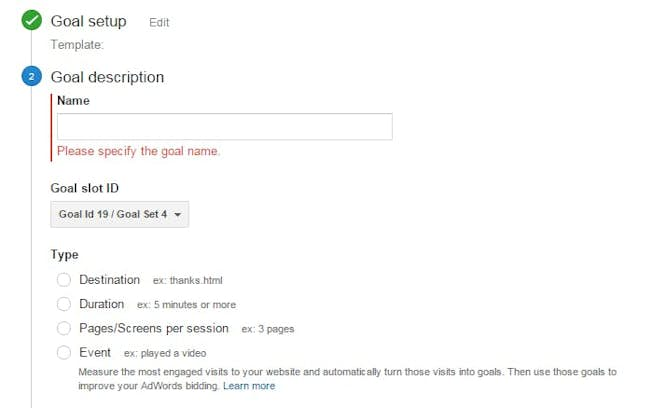What Data Is Google Analytics Goals Unable to Track: Important Details
What Data Is Google Analytics Goals Unable to Track: Important Details
Blog Article
Discover the Limitations of Google Analytics Goals: Revealing the Information Kind That Remain Untrackable
As businesses significantly depend on data-driven decision-making, understanding the limitations of devices like Google Analytics ends up being paramount. While Google Analytics Goals offer important insights right into customer interactions, there exist information types that avoid monitoring, positioning challenges to a comprehensive understanding of customer behavior.
Incomplete Customer Journey Tracking
Incomplete customer trip tracking within Google Analytics can hinder the ability to properly analyze user actions. When the customer trip is not fully tracked, there are gaps in the data that avoid a thorough understanding of how users connect with a website. This lack of understanding can lead to missed opportunities for optimization and improvements to the customer experience.
One usual concern with insufficient individual journey tracking is the inability to see the full course that customers take in the past finishing a goal or leaving the site. Without this details, it is testing to recognize where customers might be running into barriers or friction points that prevent them from converting. Additionally, insufficient monitoring can cover the effect of certain marketing initiatives or internet site changes on user behavior.
To address this restriction, it is vital to establish appropriate tracking mechanisms within Google Analytics to capture the whole customer journey. This might include establishing event monitoring, goal funnels, or using tools like Google Tag Manager to ensure that no important interactions go unrecorded. By getting a detailed view of the customer journey, internet site owners can make even more enlightened decisions to boost individual engagement and drive conversions.
Acknowledgment Difficulties
Browsing through attribution obstacles in Google Analytics requires a thorough understanding of exactly how various touchpoints add to the total conversion process. Attribution difficulties develop from the intricacy of modern-day consumer trips, where customers communicate with several networks prior to converting.
One common attribution obstacle is the trouble in associating conversions to the right source, especially in instances where individuals engage with several channels prior to converting. Furthermore, cross-device tracking postures one more acknowledgment difficulty, as users often switch over between devices throughout their journey, making it testing to track their interactions seamlessly.
Offline Conversions
Provided the difficulties connected with connecting conversions accurately in online networks, the measurement of offline conversions presents a significant possibility for marketing professionals seeking a much more extensive understanding of their consumers' journey. Offline conversions refer to activities that customers absorb the physical globe, such as making purchases in brick-and-mortar stores or over the phone, participating in events, or involving with printed materials - what data is google analytics goals unable to track. These conversions are crucial for services that run both online and offline, as they offer beneficial insights into the efficiency of advertising and marketing projects across different touchpoints
Tracking offline conversions commonly posed a considerable challenge for marketing professionals, as it was testing to link these activities back to particular on-line interactions precisely. With improvements in modern technology, such as the integration of CRM systems, distinct identifiers, and discount coupon codes, organizations can now bridge the space in between online and offline information to gain an extra alternative sight of client habits. By efficiently measuring offline conversions, marketers can optimize their strategies, allocate sources extra successfully, and inevitably boost the general client experience.
Cross-Device Monitoring
Cross-device tracking plays an essential role in understanding the interconnected nature of customers' electronic interactions throughout numerous gadgets. In today's omnichannel world, where users flawlessly change between desktop computers, mobile phones, and tablets, tracking their habits across these devices is essential for marketers to obtain a detailed view of their customer trip.

Additionally, personal privacy concerns and policies such as GDPR and CCPA have additionally difficult cross-device tracking. With users demanding more control over their data and enhanced limitations on monitoring modern technologies, marketing professionals should locate privacy-compliant and innovative means to link individual communications across gadgets.
Dynamic Web Content Interaction
Understanding customer interaction with vibrant material is essential in optimizing electronic marketing approaches for boosted audience communication. Dynamic content refers to web site elements that change based on customer habits, preferences, or other factors, offering a personalized experience. Nevertheless, tracking user communications with dynamic web content postures difficulties for conventional analytics tools like Google Analytics.
While Google Analytics can track fundamental interactions like clicks and web page views, it may battle to record even more nuanced interactions within dynamic web content. what data is google analytics goals unable to track. Metrics such as time invested in specific vibrant elements, float actions, or interactions within pop-ups are often not easily quantifiable using standard monitoring techniques. This limitation prevents marketing experts' capability to totally realize just how customers are engaging with vibrant content and customize their strategies appropriately

Verdict
In final thought, Google Analytics objectives have restrictions in tracking insufficient customer trips, connecting conversions precisely, catching offline conversions, tracking cross-device interactions, and gauging vibrant material engagement. These restraints highlight the relevance of exploring added tracking browse around this web-site approaches and devices to gain a much more comprehensive understanding of customer actions and conversions beyond what Google Analytics can provide.
While Google Analytics Goals offer useful insights into user interactions, there exist information types that thwart tracking, positioning difficulties to an extensive understanding of customer habits.Insufficient user trip tracking within Google Analytics can prevent the capability to accurately examine user behavior. When the customer trip is not completely tracked, there are gaps in the data that protect against a detailed understanding of just how customers interact with a web site.One usual concern with incomplete user journey monitoring is the inability to see the full course that users take previously completing an objective or leaving the website. By getting a detailed view of the user trip, web site proprietors can make more enlightened choices to boost individual engagement and drive conversions.
Report this page